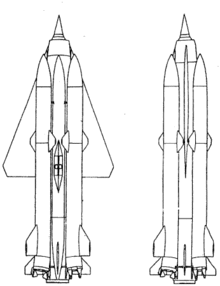
Summary
The Buran (Russian: Буран, named for the Buran wind) cruise missile, designation M-40 (М-40) sometimes referred to as RSS-40, was a Soviet intercontinental cruise missile by Myasishchev capable of carrying a 3,500 kg hydrogen bomb payload.[1] The project was canceled before flight tests began.[2] It is unrelated to the later Buran reusable orbiter.

Development edit
The project was authorized on 20 May 1954, parallel to the development of the Burya missile. The development however, began in April 1953 as a rocket-aircraft system by Myasishchev OKB with internal designation M-40.[3] The project was canceled in November 1957, when two prototypes were just ready for flight testing, in favor of the R-7 Semyorka, since ICBMs were considered unstoppable. Like the Burya, the Buran consisted of two stages, the booster rockets designated M-41, and the cruise missile stage designated M-42.[citation needed]
Specifications edit
General characteristics edit
- Function: Nuclear cruise missile
- Launch mass: 125000 kg
- Total length: 24.0 m
- Launch platform: Launch pad
- Status: Canceled before first flight tests
Launch vehicle (M-41) edit
- Engine: 4× RD-213
- Thrust: 4× 55 t
- Length: 19.1 m
- Diameter: 1.20 m
- Oxidizer: Liquid oxygen
- Combustible: Kerosene
Cruise missile (M-42) edit
- Engine: 1× RD-020 ramjet
- Speed : Mach 3.1–3.2
- Range: 8,500 km
- Flight altitude: 18–20 km
- Warhead: thermonuclear, 3500 kg
- Length: 23.3 m
- Diameter: 2.40 m
- Wing span: 11.6 m
- Wing area: 98 m2
Comparable missiles edit
References edit
- ^ Hendrickx, Bart; Vis, Bert (2007-12-05). Energiya-Buran: The Soviet Space Shuttle. Springer. ISBN 9780387739847.
- ^ "FAS.org – "Burya / Buran- Russian / Soviet Nuclear Forces"". Retrieved 2006-06-17.
- ^ ""Astronautix.org – "Buran"". Archived from the original on February 28, 2002. Retrieved 2006-06-17.


